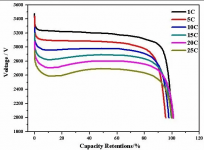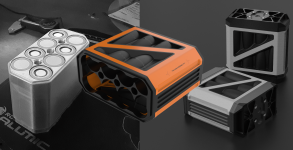Here’s my ACA mini with 3d printed chassis and I’m powering it with a 6s lipo. Sounds amazing, and not just for the money.

No hook-up wiring, no power supply wiring,... excellent power supply, simplistic 2-gain stage class A-ish design, dense plastics. Perfect combination.
Here’s my ACA mini with 3d printed chassis and I’m powering it with a 6s lipo. Sounds amazing, and not just for the money.
It's good to see RC model equipment and connectors being used for audio. I've been an avid electric RC flyer for many years.
I'm running my M2 on LIFEPO4 and the discharge curve on said chemistry is FREAKISHLY FLAT! Nothing like the dead silence of a direct battery.With 6s 2800 I’m running it for about 1 hour. Voltage drop with lipos is so linear that it’s not a problem and the bias isn’t changing. I’ve also got tons of 6s 3300s that I’m staring to use. So, two of those for an evening of listening.
Lipo powered this thing sounds really amazing. Easily as good as any of my Pass or tube amps.
Attachments
Looks great - Good job! Here’s mine FWIW… “Not your grandmother’s toaster” 😎
Attachments
= lots of amazing performance.No hook-up wiring, no power supply wiring,... excellent power supply, simplistic 2-gain stage class A-ish design, dense plastics. Perfect combination.
Good to hear. I do plan to try other FWDIY designs (as I have a pile of them) with larger packs, let’s say 6s 5000s on each channel.I'm running my M2 on LIFEPO4 and the discharge curve on said chemistry is FREAKISHLY FLAT! Nothing like the dead silence of a direct battery.
Batteries have their own noise floor, but in audio they deliver the best I have ever heard. My favorite PI filter supply is C-L-C (my Singing Bush build) (or C-L-C-L-C) as they deliver remarkably quiet power. However, After hearing a lipo powered class A Nelson design I’m not sure I can go back to what I thought was really good.
The current delivery of the battery provides remarkable LF authority to the amp that it did not have with the brick. Additionally the space around instruments just sounds much quieter and I think the tones are the most remarkable thing: they just sound organic.
Caution: I’ve been using Li-po / Li-ion batteries for about 18 years and you just have to use some care with both charging and storing. Also, modern lipos discharge at extreme rates so avoid being shocked by them. On the other hand, my point to point amps have shocked me many times and I’ve never been shocked by a lipo even when I’ve done something brainless (trying to plug them into a paraboard backwards for example).
Recommendation: Do some reading before using them. They are not hard to deal with but please just educate yourself first.
It's funny.. I'm in the process of building an AC mains PSU and happened to finally get my battery strategy dialed in the interim--and now I'm struggling to find the motivation to complete the PSU! My priorities instantly shifted to other things like speakers, crossover, etc. 'How far can I go with the rig' became the new mantra after just a few listening sessions. I'm wanting to do a quad M2 with the Pass active crossover and get my two-way system maxed out.After hearing a lipo powered class A Nelson design I’m not sure I can go back to what I thought was really good.
Your points on safety cannot be overstated. A dead short will frighteningly demonstrate the kind of power on tap. The other issue is a potential for catastrophic failures that occur independent of bad work habits. Nasa research on isolating thermal runaway is well established and I have my own spinoff of the strategy; burry can cells in a slab of aluminum, which will draw enough heat from a given runaway cell that a cascade is prevented. Safer chemistries are another practical method. LIFEPO4 happens to be quite resistant to runaway, and Lithium Titanate is practically impossible to initiate runaway. My batteries are in the 1-2kW range and a runaway battery that size is not something that can be easily extracted from a room. I'm also working on smaller monolith packs that are more akin to the packs you are running, albeit I use the 21700 form factor.
Here's current progress on a runaway resistant 1U 1kW chassis and a smaller 8s brick. For the smaller bricks I'm working out ways to do a hybrid where each can is separated by aluminum but the outer case is a high-temp engineering plastic. My goal is to make high-grade enclosures at different price points and going with polymers is key to that end:
Attachments
Last edited:
Super cool stuff Haze Head and Ggetzoff, looks like another rabbit hole to explore 🙂
Wow, those are really neat designs / ideas. I have never (to this date) had a battery failure or a runaway cell (even after hard crashes (in models!). The only time I have ever seen a failure has been when cells were over-volted by user error during charging (i.e. wrong number of cells selected).It's funny.. I'm in the process of building an AC mains PSU and happened to finally get my battery strategy dialed in the interim--and now I'm struggling to find the motivation to complete the PSU! My priorities instantly shifted to other things like speakers, crossover, etc. 'How far can I go with the rig' became the new mantra after just a few listening sessions. I'm wanting to do a quad M2 with the Pass active crossover and get my two-way system maxed out.
Your points on safety cannot be overstated. A dead short will frighteningly demonstrate the kind of power on tap. The other issue is a potential for catastrophic failures that occur independent of bad work habits. Nasa research on isolating thermal runaway is well established and I have my own spinoff of the strategy; burry can cells in a slab of aluminum, which will draw enough heat from a given runaway cell that a cascade is prevented. Safer chemistries are another practical method. LIFEPO4 happens to be quite resistant to runaway, and Lithium Titanate is practically impossible to initiate runaway. My batteries are in the 1-2kW range and a runaway battery that size is not something that can be easily extracted from a room. I'm also working on smaller monolith packs that are more akin to the packs you are running, albeit I use the 21700 form factor.
Here's current progress on a runaway resistant 1U 1kW chassis and a smaller 8s brick. For the smaller bricks I'm working out ways to do a hybrid where each can is separated by aluminum but the outer case is a high-temp engineering plastic. My goal is to make high-grade enclosures at different price points and going with polymers is key to that end:
In the end, this is a hobby and you have to try new things. In this case it was a huge performance increase. What we really need is a charging and disconnect from the mains system like IanCanada’s LifePo4 setup.
Same here. I have intentionally tried to force half a dozen different battery makes into runaway and none of them would do it. Granted, I mostly use the milder energy density cells. Nevertheless, this can and does happen regularly:
I do love that 3D printed base! Here I have a service for 3d printing but I have no idea of how to make a suitable file for it.Here’s my ACA mini with 3d printed chassis and I’m powering it with a 6s lipo. Sounds amazing, and not just for the money.View attachment 1124760View attachment 1124761

When that wooden "Live Laugh Love & Learn" sign hanging over the kitchen wine rack finally speaks truth to power.„Oopsie“
- Home
- Amplifiers
- Pass Labs
- Pictures of your diy Pass amplifier




